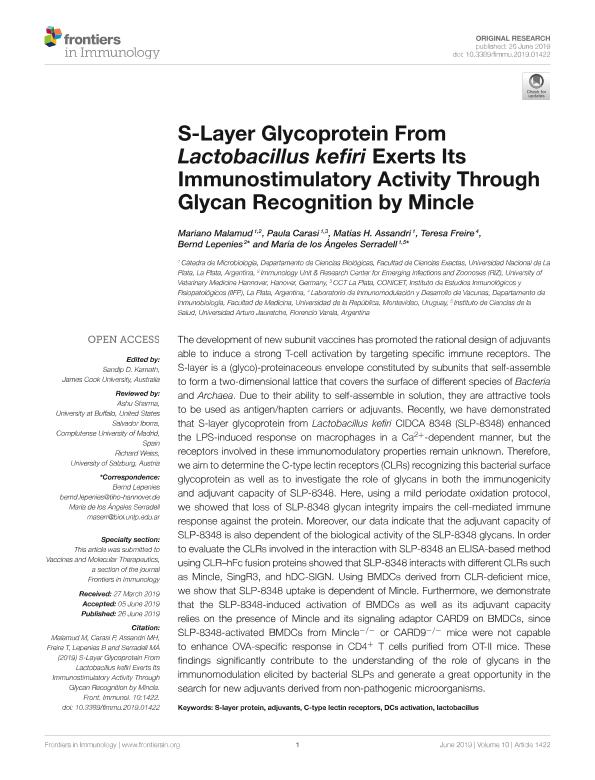Mostrar el registro sencillo del ítem
dc.contributor.author
Malamud, Mariano

dc.contributor.author
Carasi, Paula

dc.contributor.author
Assandri, Matías Hernán

dc.contributor.author
Freire, Teresa
dc.contributor.author
Lepenies, Bernd
dc.contributor.author
Serradell, María de los Ángeles
dc.date.available
2022-02-17T20:08:29Z
dc.date.issued
2019-06-26
dc.identifier.citation
Malamud, Mariano; Carasi, Paula; Assandri, Matías Hernán; Freire, Teresa; Lepenies, Bernd; et al.; S-Layer glycoprotein from Lactobacillus kefiri exerts its immunostimulatory activity through glycan recognition by Mincle; Frontiers Media; Frontiers in Immunology; 10; 26-6-2019; 1-11
dc.identifier.issn
1664-3224
dc.identifier.uri
http://hdl.handle.net/11336/152228
dc.description.abstract
The development of new subunit vaccines has promoted the rational design of adjuvants able to induce a strong T-cell activation by targeting specific immune receptors. The S-layer is a (glyco)-proteinaceous envelope constituted by subunits that self-assemble to form a two-dimensional lattice that covers the surface of different species of Bacteria and Archaea. Due to their ability to self-assemble in solution, they are attractive tools to be used as antigen/hapten carriers or adjuvants. Recently, we have demonstrated that S-layer glycoprotein from Lactobacillus kefiri CIDCA 8348 (SLP-8348) enhanced the LPS-induced response on macrophages in a Ca2+-dependent manner, but the receptors involved in these immunomodulatory properties remain unknown. Therefore, we aim to determine the C-type lectin receptors (CLRs) recognizing this bacterial surface glycoprotein as well as to investigate the role of glycans in both the immunogenicity and adjuvant capacity of SLP-8348. Here, using a mild periodate oxidation protocol, we showed that loss of SLP-8348 glycan integrity impairs the cell-mediated immune response against the protein. Moreover, our data indicate that the adjuvant capacity of SLP-8348 is also dependent of the biological activity of the SLP-8348 glycans. In order to evaluate the CLRs involved in the interaction with SLP-8348 an ELISA-based method using CLR–hFc fusion proteins showed that SLP-8348 interacts with different CLRs such as Mincle, SingR3, and hDC-SIGN. Using BMDCs derived from CLR-deficient mice, we show that SLP-8348 uptake is dependent of Mincle. Furthermore, we demonstrate that the SLP-8348-induced activation of BMDCs as well as its adjuvant capacity relies on the presence of Mincle and its signaling adaptor CARD9 on BMDCs, since SLP-8348-activated BMDCs from Mincle−/− or CARD9−/− mice were not capable to enhance OVA-specific response in CD4+ T cells purified from OT-II mice. These findings significantly contribute to the understanding of the role of glycans in the immunomodulation elicited by bacterial SLPs and generate a great opportunity in the search for new adjuvants derived from non-pathogenic microorganisms.
dc.format
application/pdf
dc.language.iso
eng
dc.publisher
Frontiers Media

dc.rights
info:eu-repo/semantics/openAccess
dc.rights.uri
https://creativecommons.org/licenses/by/2.5/ar/
dc.subject
S-LAYER PROTEIN
dc.subject
ADJUVANTS
dc.subject
C-TYPE LECTIN RECEPTORS
dc.subject
LACTOBACILLUS
dc.subject
DCs ACTIVATION
dc.subject.classification
Otras Ciencias Biológicas

dc.subject.classification
Ciencias Biológicas

dc.subject.classification
CIENCIAS NATURALES Y EXACTAS

dc.title
S-Layer glycoprotein from Lactobacillus kefiri exerts its immunostimulatory activity through glycan recognition by Mincle
dc.type
info:eu-repo/semantics/article
dc.type
info:ar-repo/semantics/artículo
dc.type
info:eu-repo/semantics/publishedVersion
dc.date.updated
2020-12-09T15:26:08Z
dc.journal.volume
10
dc.journal.pagination
1-11
dc.journal.pais
Suiza

dc.description.fil
Fil: Malamud, Mariano. Universidad Nacional de La Plata. Facultad de Ciencias Exactas. Departamento de Ciencias Biológicas. Cátedra de Microbiología General; Argentina. University of Veterinary Medicine Hannover; Alemania. Consejo Nacional de Investigaciones Científicas y Técnicas. Centro Científico Tecnológico Conicet - La Plata; Argentina
dc.description.fil
Fil: Carasi, Paula. Universidad Nacional de La Plata. Facultad de Ciencias Exactas. Departamento de Ciencias Biológicas. Cátedra de Microbiología General; Argentina. Consejo Nacional de Investigaciones Científicas y Técnicas. Centro Científico Tecnológico Conicet - La Plata. Instituto de Estudios Inmunológicos y Fisiopatológicos. Universidad Nacional de La Plata. Facultad de Ciencias Exactas. Instituto de Estudios Inmunológicos y Fisiopatológicos; Argentina
dc.description.fil
Fil: Assandri, Matías Hernán. Universidad Nacional de La Plata. Facultad de Ciencias Exactas. Departamento de Ciencias Biológicas. Cátedra de Microbiología General; Argentina. Consejo Nacional de Investigaciones Científicas y Técnicas. Centro Científico Tecnológico Conicet - La Plata; Argentina
dc.description.fil
Fil: Freire, Teresa. Universidad de la República; Uruguay
dc.description.fil
Fil: Lepenies, Bernd. University of Veterinary Medicine Hannover; Alemania
dc.description.fil
Fil: Serradell, María de los Ángeles. Universidad Nacional de La Plata. Facultad de Ciencias Exactas. Departamento de Ciencias Biológicas. Cátedra de Microbiología General; Argentina. Universidad Nacional Arturo Jauretche; Argentina
dc.journal.title
Frontiers in Immunology
dc.relation.alternativeid
info:eu-repo/semantics/altIdentifier/doi/http://dx.doi.org/10.3389/fimmu.2019.01422
dc.relation.alternativeid
info:eu-repo/semantics/altIdentifier/url/https://www.frontiersin.org/articles/10.3389/fimmu.2019.01422/full
Archivos asociados
